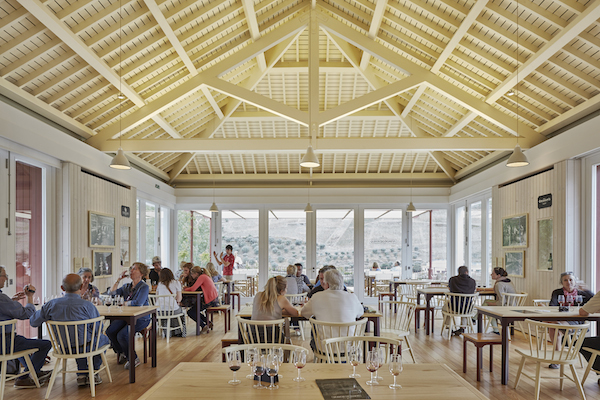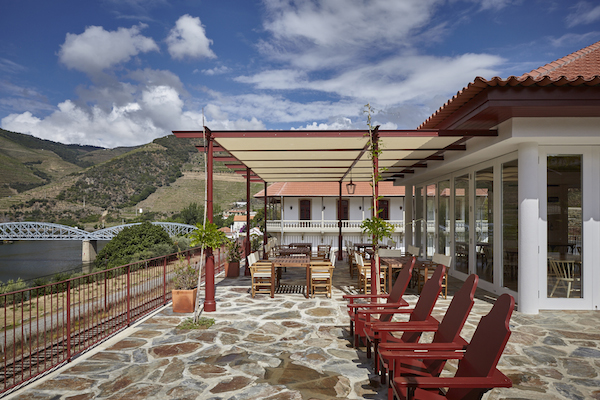It used to take the Symingtons of the famous port family 12 minutes to commute by speedboat between the family’s two wine farms on the river Douro, Quinta do Bomfim and Quinta dos Malvedos, but today it’s much longer. They have to proceed with unaccustomed caution because of the wash from so many large pleasure boats on the river. Ricardo Sousa Campos is the commercial director of Quinta da Romaneira and, like most of those in the northern Portuguese wine business, is based in the principal city Oporto. But he is trying to move out. ‘You can’t move for tourists nowadays. Everyone’s signing up for AirBnB.’
Like Lisbon, Oporto, or Porto as it is known in Portuguese, is buzzing – perhaps benefiting from the downturn in tourism to the likes of Turkey and North Africa. Ryanair fly in tourists from 12 countries, Easyjet from five.
Last month for the first time in a few years I visited the spruced-up city and the beautiful Douro Valley upstream. I was amazed by the growth in tourism there – not least because when I first visited the city in 1976 it was truly grimy and seemed to be full of dirty washing, cobbles and barefoot children. According to the official figures, the number of hotel bed nights has risen by 57% since 2012, with revenues from hotels alone up 70% in the same period – not counting AirBnB and the like. Oporto expects to notch up 10 million bed nights in 2018. On every corner there seem to be stylish bars and restaurants that would not look out of place in Barcelona or Milan, and even the staid old port lodges in Vila Nova de Gaia across the river from the old city have transformed themselves into wine-themed ‘experiences’ complete with multilingual guides, souvenir shops and eating places.
Adrian Bridge, managing director of The Fladgate Partnership, which, with Taylor, Fonseca and Croft, is a major player in the port business, is now almost better known as a hotelier. He converted a bit of surplus land next to the Taylor’s lodge in Vila Nova de Gaia into The Yeatman, a luxurious hotel with a Michelin-starred restaurant, and is currently drawing up plans for a similar transformation of the Infante de Sagres, traditionally Oporto’s most famous hotel. Over last winter he performed the same trick on The Vintage House in Pinhão, the Douro Valley’s biggest hotel overlooking all those excursion boats.
There are generous EU subsidies and loans for both building and renovating hotels, which has encouraged other wine producers to go into the hotel business, not just in Oporto and Gaia but up in what was until recently the sparsely populated Douro Valley, thereby adding considerably to employment prospects there. Quinta de la Rosa just outside the little port town of Pinhão, for example, operates a popular small hotel as well as an admired wine farm.
The team behind another highly regarded producer of Douro table wines Quinta do Vallado has built 13 rooms at the quinta downstream of Pinhão but, more ambitiously, has created a particularly eco-friendly eight-room hotel Casa do Rio (river house) way upriver in the deserted Douro Superior region on the Spanish border. João Ferreira Álvares Ribeiro of Quinta do Vallado told me that from May this year they have enjoyed 100% occupancy and that their activities providing bed and board now represent 20% of total turnover. ‘We stick to table d’hôte so the margins are good – much better than in the wine business', he said contentedly. He is worried that tourism in his region is growing dangerously fast, but admits that it certainly helps the reputation of his wines. ‘This year we’ll sell 200,000 euros' worth of wine in our shop – at double margin. That’s more than our sales to most export markets.’
The growth of tourism must be some consolation for Portuguese wine exporters who are currently grappling with the fallout from the economic collapse of not just one but both of their biggest export markets, Angola and Brazil.

The evolution of the Douro Valley from deserted UNESCO World Heritage site to tourist playground (the pictures here are of the new visitor centre at Quinta do Bomfim in Pinhão) has been helped enormously by recent road building. Part of the magic of the Douro’s extreme climate – blisteringly hot summers and testing winters – is because of the mountains as high as Ben Nevis that shield it from the Atlantic. When Adrian Bridge first came to Portugal in 1982 it took five and a half hours to drive to Taylors’ famous Quinta de Vargellas in the Douro Valley but now it takes no more than two, thanks in particular to a 5.4-kilometre tunnel that opened last May. It is so new that when wine producer Dirk Niepoort drove me to the airport from the Douro last month he initially forgot to take the new time-saving route.
It was only in the late 1970s that electricity arrived in the Douro – facilitated by the dams that have transformed a fast-moving river, with potentially dangerous rapids over which flat-bottomed boats loaded with barrels of port used to be navigated every spring, into a series of lakes connected with locks for the pleasure boats. Port used to be foot-trodden in semi darkness – just the sort of spectacle that would most appeal to tourists today – but rising labour costs and the arrival of electricity have resulted in a range of automated alternatives involving various forms of stainless steel and silicone pads designed to emulate the human sole.
The old days when local workers were expected to spend eight back-breaking hours picking grapes in the steep vineyards followed by four treading them in the winery are long gone, although a small proportion of top-quality port today is still (just) trodden by 80 sticky purple feet. (This has in its time caused some upset in some of the more fastidious markets. Japan, for instance.)

Looking ahead to even greater challenges finding labour, one of the most powerful port technicians, Charles Symington, the most hands-on member of the family responsible for Dow, Graham's, Warre and now Cockburn ports, has just begun trying out a mechanical grape harvester in the Douro. The terrain is so steep and varied, largely made up of narrow terraces, that it is far from an obvious candidate for mechanisation. But he has found a machine designed for the steep vineyards of the Mosel Valley in Germany.
The only modification needed was apparently a reverse gear. Something it is far too late for the five Symington cousins, who invest all their dividends in new vineyards, to apply.
PORTS WORTH FLYING IN FOR
See my tasting notes on the wines below.
BOTTLE-AGED PORTS
Quinta do Noval 2014 (£495 a dozen in bond, Farr Vintners)
Quinta de Vargellas, Vinha Velha 2011 (£245 a bottle, The Vintage Port Shop, Hampshire)
Dow 2011 (£125 a bottle, Soho Wine Supply)
Taylor's 2000 (£344.04 for six bottles, Berry Bros & Rudd)
Quinta do Vesúvio 1994 (£53.59 a bottle, Nethergate Wines)
Quinta de Vargellas 1987 (£79.95 a bottle, The Vintage Port Shop)
Graham's 1985 (£60 a bottle, Palmers Wine Store, Dorset)
Taylor's 1977 (£99 a bottle, Four Walls Wine)
Quinta dos Malvedos 1965 (£225 a bottle, Cambridge Wine Merchants)
WOOD-AGED PORTS
Graham's 1972 Single Harvest (£207 a bottle, Hedonism)
Taylor's 40 Year Old Tawny (£98.98 a bottle Winedancer.com)













